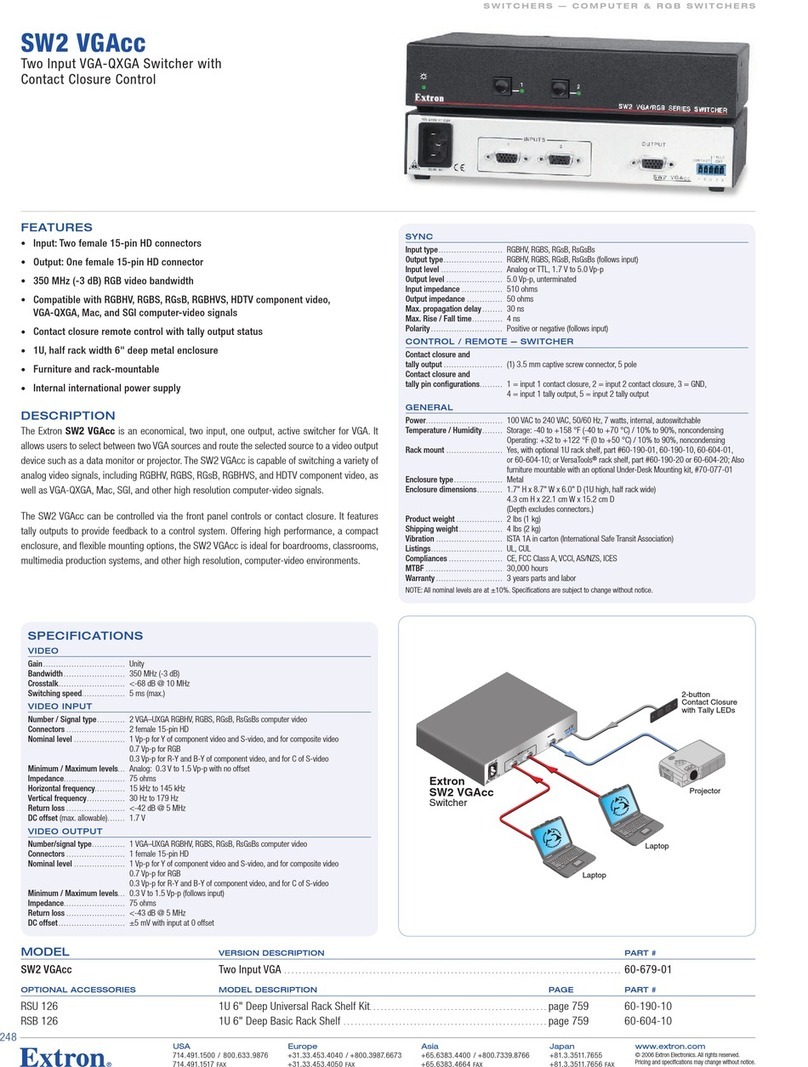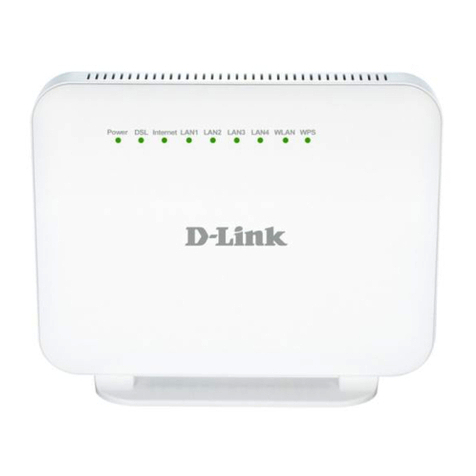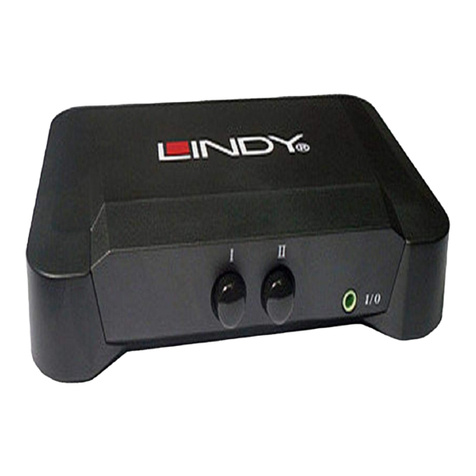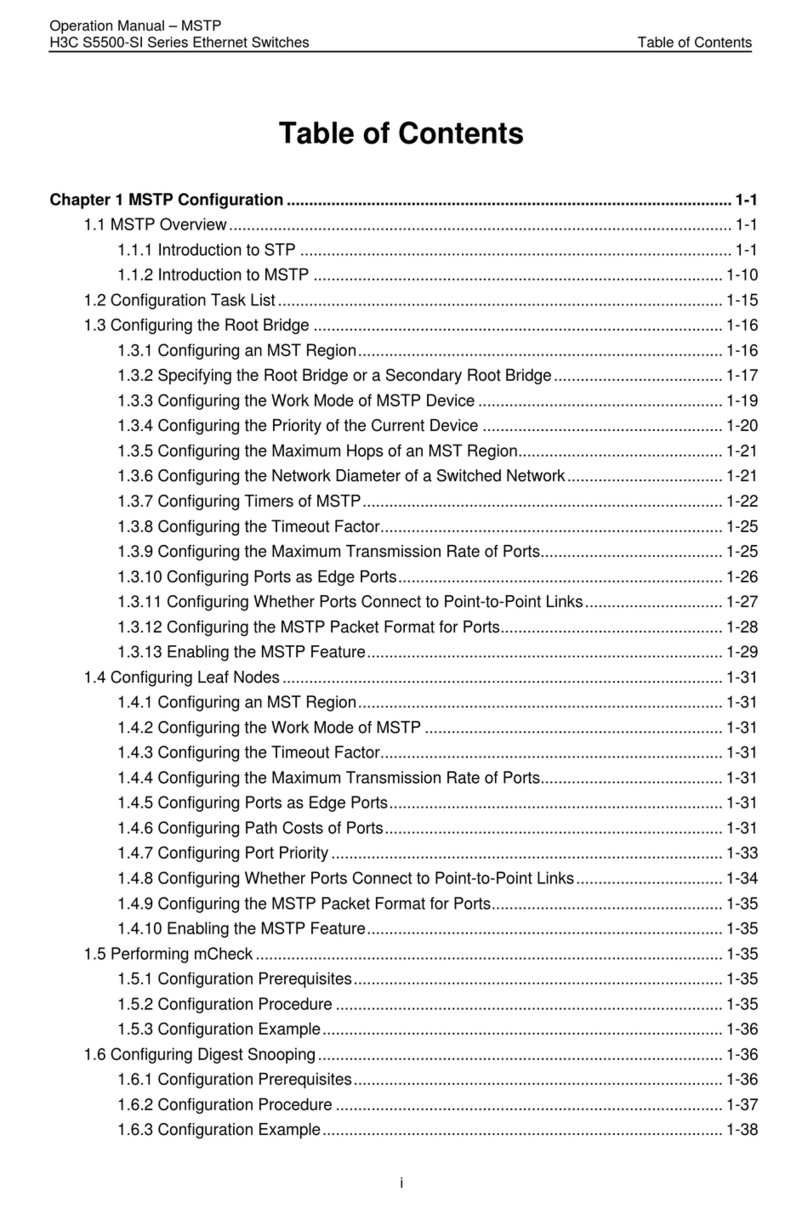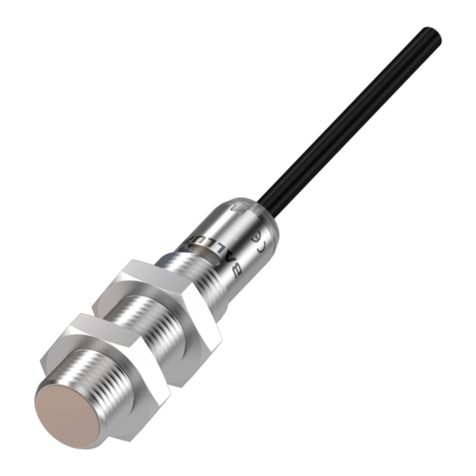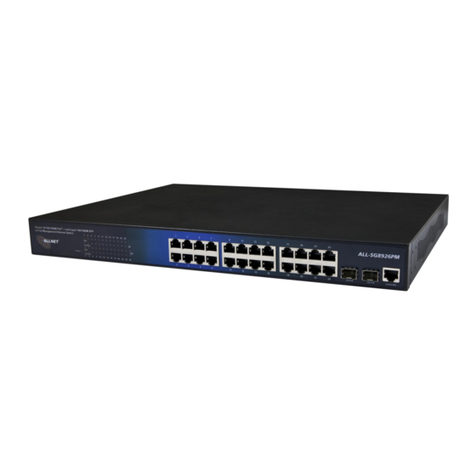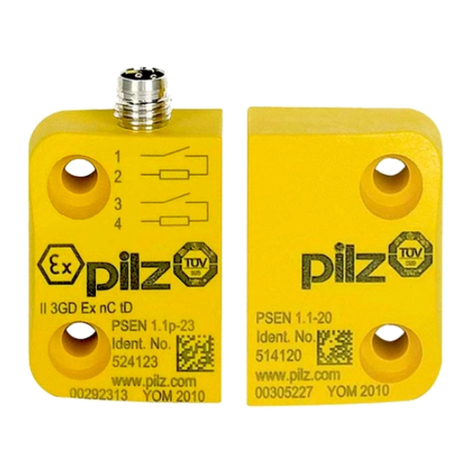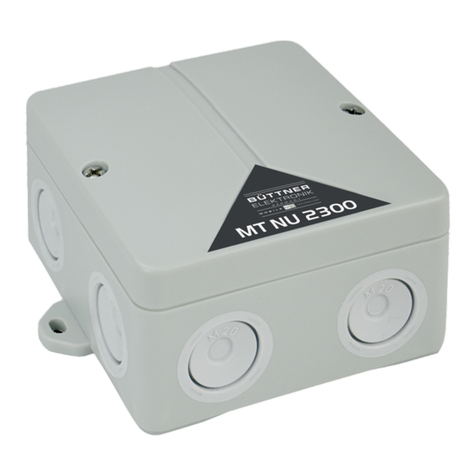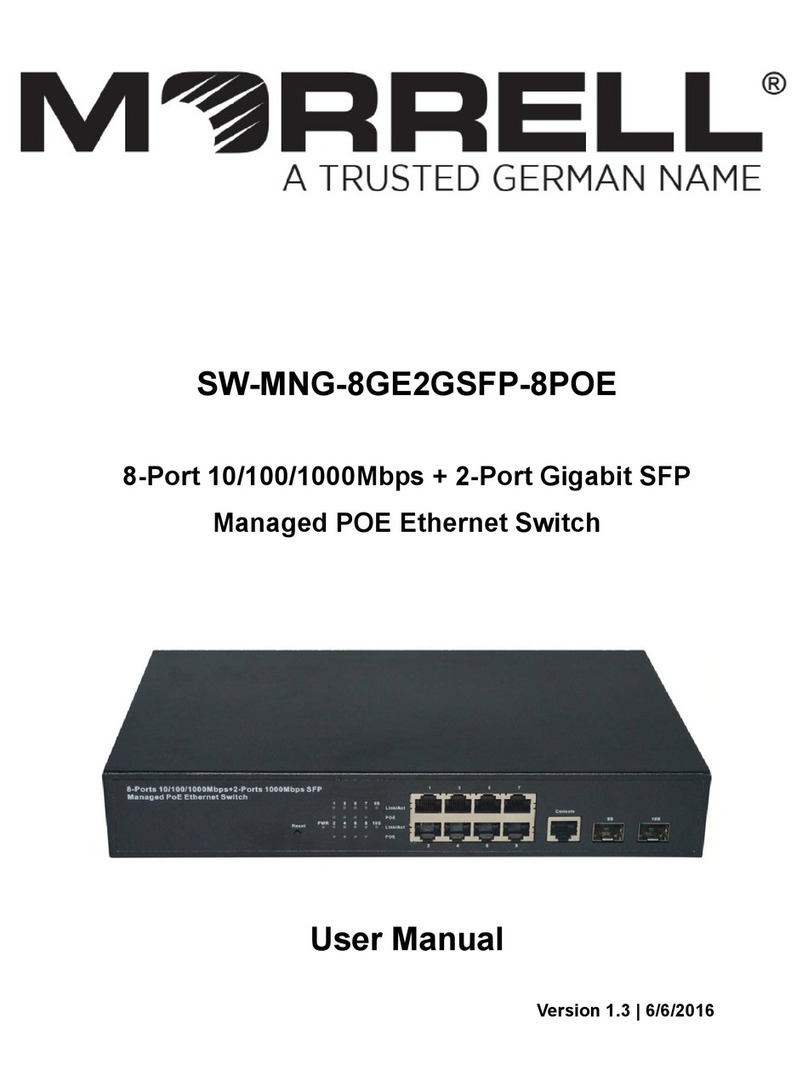Timpdon Electronics SCS2 User manual

Timpdon Electronics Tel 0161 -980 7804 Issue 2–October 2010
Web www.timpdon.co.uk
Features
•Controlled motion between two servo positions with a single switch, using a
standard RC servo.
•Fully user programmable for independent servo end positions,rotation
speed andend of travel bounce. Programmed settings retained when power
removed.
•Sense output at end of throw, in both directions –permits daisy chaining of
units with sequential operation, or external indication of servo position.
•Ideal for control of crossing gates, points and semaphore signals.
•Digital microprocessor controlled.
•Small size –50mm x 25mm x 16mm.
•4.8 V to 6 V d.c. supply.
•Screw terminals forconnections to supply,control switch and sense output.
3pin plug for direct servo connection.
Timpdon
Electronics
ServoSwitch
Model SCS2

Timpdon Electronics Tel 0161 -980 7804 Issue 2–October 2010
Web www.timpdon.co.uk
Installation and Wiring
Operating
Switch
[Closed = Set]
S1 S2
LED
V+
Control
0V Red
Yellow
Black
Connections to Servo
+4.8 to +6V
0 V
SCS2
Sense Output
SwitchInput
Notes
1Connect a d.c. supply of between 4.8 V and 6V to the screw terminals, as
shown. –Please read the Cautionary Notes below, before selecting your
power source.
Do not exceed the maximum permitted nominal supply voltage of 6 V.
Although the SCS2will accommodate higher voltages without blowing up,
many RC servos will not.
Ensure that the power supply polarity is correct before powering up.
2Connect a single pole operating switch between theswitch input terminal
and the 0V supply, as shown. Note that the Reset position of the servo, as
described below,corresponds to the switch open condition, and the Set
position to switch closed.
3The sense output will switch from +5V to 0V on completion of a Set
operation, and will switch back from 0V to +5V on completion of a Reset
operation.
This output may be connected to the switch input of another SCS2 [or
SCS1]to permit sequential operation, with the motion of the second servo
starting on completion of movement of the first, and/or used to power an
external indicator to display the current state [Set or Reset] of the servo.
Note that the maximum permitted load current on this output is 20mA.
4Plug the servo connector on to the three pin plug connector on the
opposite end of the SCS2. Ensure that the black wire on the servo is
positioned towards the bottom edge of the SCS2, adjacent to the 0V screw
terminal.

Timpdon Electronics Tel 0161 -980 7804 Issue 2–October 2010
Web www.timpdon.co.uk
Operation
1Once programmed, as described below, simply select the required servo
end position, Set or Reset using the operating switch. The servo will
move to the opposite programmed position, at the programmed rotation
speed.
2If a bounce level is programmed for the current direction of travel then, as
soon as the programmed end position is reached the servo will reverse to
the bounce position at the same speed, reverse again and finally return to
the programmed end position at the same speed. This feature may be
used to realistically simulate bounce at end of travel of semaphore signal
arms or crossing gates and barriers. If you do not require bounce in either
direction of travel, program the relevant bounce level to zero bounce.
3Once the servo has reached its programmed end position, and after a
further 1 second delay, the sense output will switch to the opposite state.
For Set, the output will switch from +5V to 0V and, for Reset, from 0V to
+5V. If this output is connected to the switch input of another servo
controlled switch, the second unit will start a Set or Reset operation on
completion of the same operation of the first unit.
4Once the servo started has started moving towards either the Set or
Reset positions it can not be stopped or reversed until it has completed its
programmed travel, as described in 3and, optionally, a further ten
seconds have elapsed [See below].
5Note that, in normal operation, the LED indicator will be off, unless the
optional 10 second delay referred to in 4is enabled. In this case, the LED
will illuminate continuously during this period. Otherwise, the LED is used
in programming mode only.

Timpdon Electronics Tel 0161 -980 7804 Issue 2–October 2010
Web www.timpdon.co.uk
Optional End of Travel Control Switch Delay
For installations in which a number of SCS2 units are connected in
sequence, for example on a two gate crossing with overlapping gates, you
may need to ensure that a complete gate sequence has completed before
a reverse operation sequence can be initiated, to avoid a potential gate
clash. To permit this, you may optionally incorporate a ten second delay
after motion has completed before the SCS2 will respond to a further
operation of the control switch.
To incorporate this delay, press and hold switch S2 when applying power
to the unit. To cancel the delay, press and hold switch S1 when applying
power. Once set or cancelled the delay value is remembered by the SCS2
and need not be set again.
Programming
Programming or re-programming may be performed at any time, using
push button switches S1 and S2, with indication provided by the LED
indicator.
Programming is performed in five steps, in order –Set Position, Reset
Position, Rotation Speed, Reset Bounce Level and Set Bounce Level.
No new programmed settings will be saved unless all five programming
steps are correctly completed, in sequence.
The Set and Reset positionsof the servo may be anywhere within the
controlled operating range of the servo –approximately 160degrees
rotation on most servos.
Programming Procedure
Press and hold both switches S1 and S2 together until the LED illuminates
continuously, after about 2 seconds. Then release both switches.
1You are now in Step 1 –Program Reset Position.
The LED will flash with single shortflashes.
Adjust the required Reset position using either S2to increase the servo
position or S1to decrease it. The actual rotation direction is servo
dependent.

Timpdon Electronics Tel 0161 -980 7804 Issue 2–October 2010
Web www.timpdon.co.uk
When satisfied, press and hold both switches S1 and S2 together until the
LED illuminates continuously, after about two seconds. Then release both
switches.
2You are now in Step 2 –Program Set Position.
The LED will flash with double short flashes.
Adjust the required set position using either S2to increase the servo
position or S1to decrease it. The actual rotation direction is servo
dependent.
When satisfied, press and hold both switches S1 and S2 together until the
LED illuminates continuously, after about two seconds. Then release both
switches.
3You are now in Step 3 –Program Rotation Speed.
The LED will flash with single long flashes.
In programming step 3, the servo will rotate continuously between the two
end positions which have already been programmed,at the current
rotation speed.
There are sixteen steps of rotation speed, varying from about 0.25 s to 20
s for 90 degree rotation. Press and releaseS2to increase the speed by
one step, or press and release S1to decrease it by one step.
Please read the Cautionary Notes below before attempting to use very
high rotation speeds.
After the last step, the rotation speed will revert to the other end of the
speed scale.
When satisfied, press and hold both switches S1 and S2 together until the
LED illuminates continuously, after about two seconds. Then release both
switches.
4You are now in Step 4 –Program Reset Bounce Level.
The LED will flash with single long followed by single short flashes.
In programming step 4, the servo will rotate continuously between the
programmed Reset position and the position represented by current Reset
Bounce level, at the programmed rotation speed.

Timpdon Electronics Tel 0161 -980 7804 Issue 2–October 2010
Web www.timpdon.co.uk
There are sixteen steps of bounce level, varying from zero to
approximately 20% of the programmed servo range between Set and
Reset. Press and releaseS2to increase the bounce level by one step, or
press and release S1to decrease it.
After the last step, the bounce level will revert to the other end of the
setting range. To disable bounce, set the bounce level to zero.
When satisfied, press and hold both switches S1 and S2 together until the
LED illuminates continuously, after about two seconds. Then release both
switches.
5You are now in Step 5 –Program Set Bounce Level.
The LED will flash with single long followed by double shortflashes.
In programming step 5, the servo will rotate continuously between the
programmed Set position and the position represented by current Set
Bounce level, at the programmed rotation speed.
There are sixteen steps of bounce level, varying from zero to
approximately 20% of the programmed servo range between Set and
Reset. Press and releaseS2to increase the bounce level by one step, or
press and release S1to decrease it.
After the last step, the bounce level will revert to the other end of the
setting range. To disable bounce, set the bounce level to zero.
When satisfied, press and hold both switches S1 and S2 together until the
LED illuminates continuously, after about two seconds. Then release both
switches.
6At this point only, programming is complete. All new settings will now be
saved in non-volatile memory, and applied to SCS2 operation. The unit will
then automatically exit programming mode,the LED will extinguish and
the SCS2 is ready for normal operation.

Timpdon Electronics Tel 0161 -980 7804 Issue 2–October 2010
Web www.timpdon.co.uk
Cautionary Notes
1The current consumption of a servo, when in motion, increases with the
rotation speed and load. At high rotation rates, the current on a single
standard servo can reach as much as 500 mA.
Most small batteries [eg AA cells] used by many modellers to power servos
can not supply this level of current without a very significant voltage drop,
in the order of one or two volts,at the battery terminals. With 4.8V
supplies, or with partially discharged batteries, this may well result in erratic
servo operation if the battery terminal voltage falls below the minimum
specified servo operating voltage.
If you experience such erratic operation, either reduce the servo rotation
speed or improve your power supply arrangements before assuming that the
SCS2 is faulty and returning it for repair.
2Although the rotation rate of the SCS2 can be programmed to a maximum
speed of 0.25 seconds for 90 degree rotation, many servos can not achieve
this speed
If you program a rotation speed higher than the servo can actually achieve
the servo will not be able to keep up with the programmed output of the
SCS2 when moving betweenSet and Reset, and vice versa.
If this occurs, and you have bounce levels programmed, the actual bounce
levels achieved in normal operation may vary considerably from those
programmed, or even be lost completely. This problem is likely to be more
apparent if you have programmed a large angle of rotation betweenSet and
Reset.
If this happens, reduce the programmed rotation speed until the effect is
corrected, or change the servo for one with a higher maximum rotation
speed.
For the ACOMS AS17 servo, supplied by Timpdon Electronics, the
maximum specified rotation rate is approximately 0.35 s for 90 degree
rotation at 5V.

Timpdon Electronics Tel 0161 -980 7804 Issue 2–October 2010
Web www.timpdon.co.uk
Other Timpdon ServoSwitches
Model SCS1
User Notes
Identical in performance and
operation to SCS2, but without the
sense output.
Recommended for use for control of
single signals or points, or at the
end of a series of daisy-chained
SCS2 units, where no further
sequential operation of servos is
required.
Table of contents
Other Timpdon Electronics Switch manuals
Popular Switch manuals by other brands
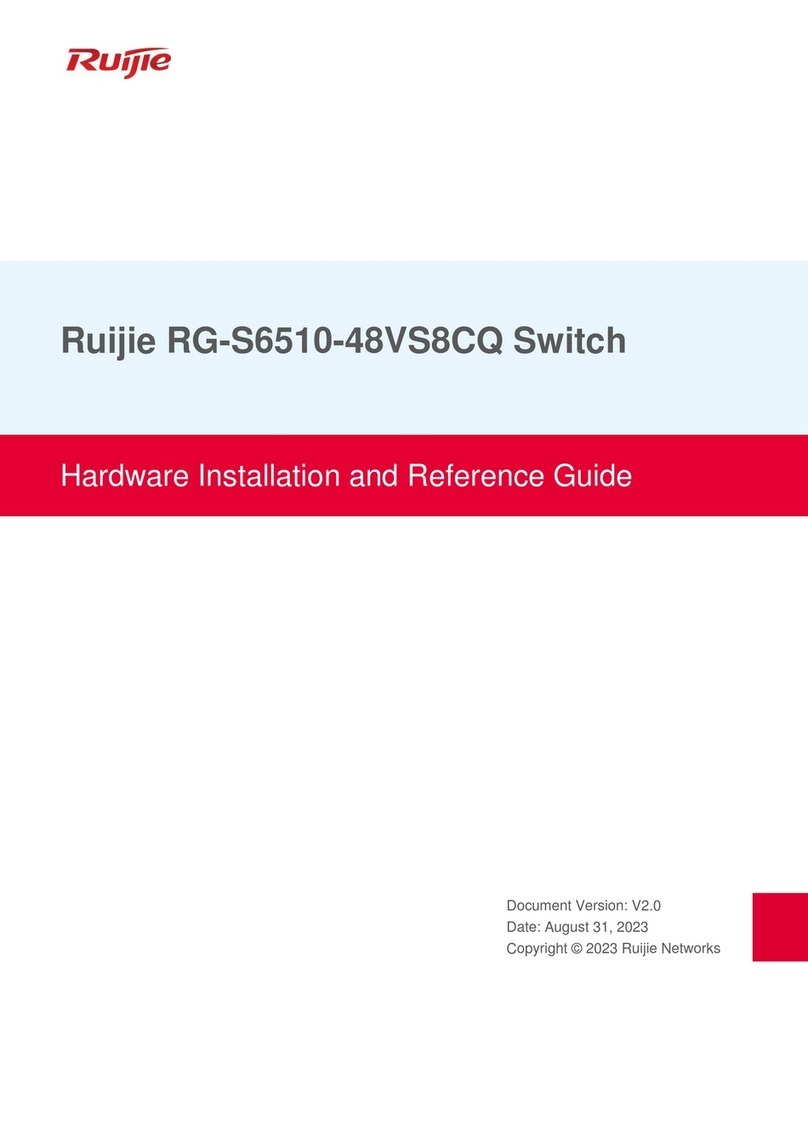
Ruijie
Ruijie RG-S6510-48VS8CQ Hardware installation and reference guide
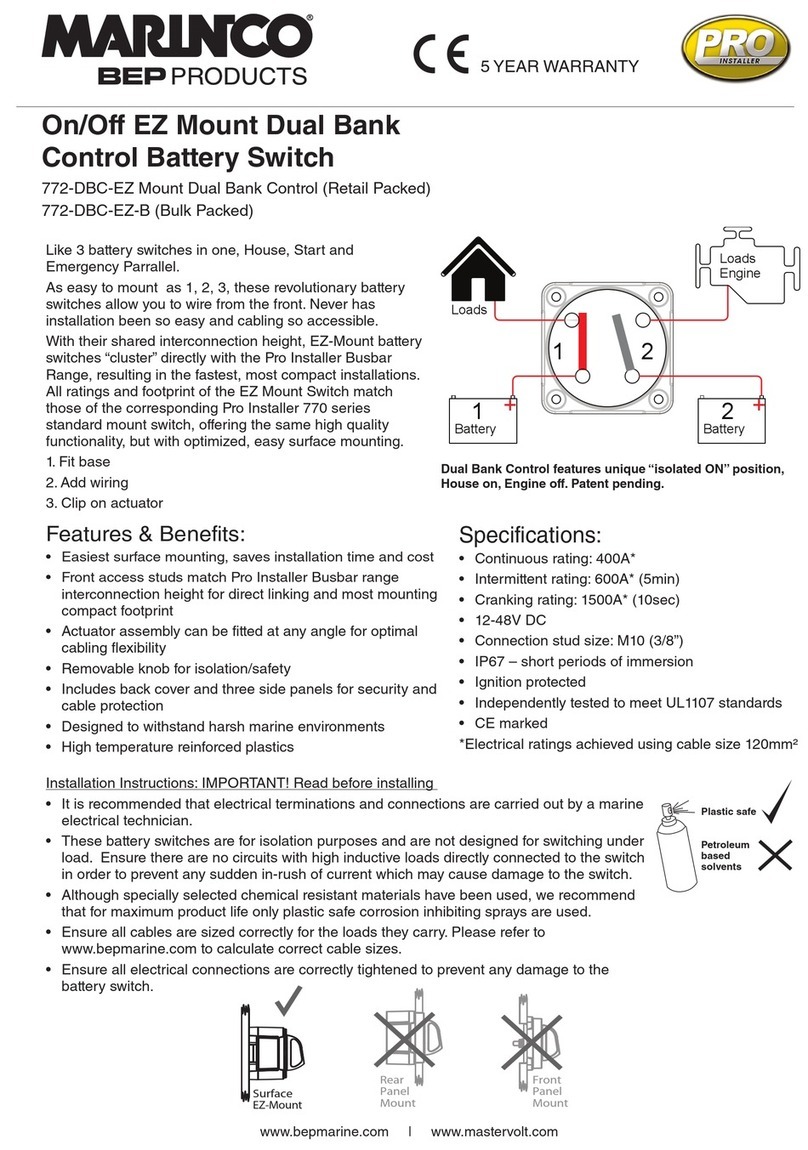
marinco
marinco 772-DBC-EZ Installation instructions manual
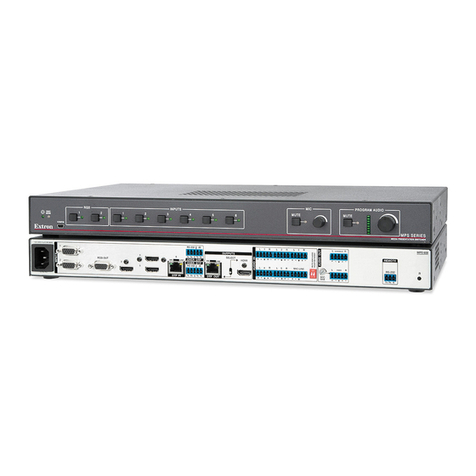
Extron electronics
Extron electronics MPS 602 user guide
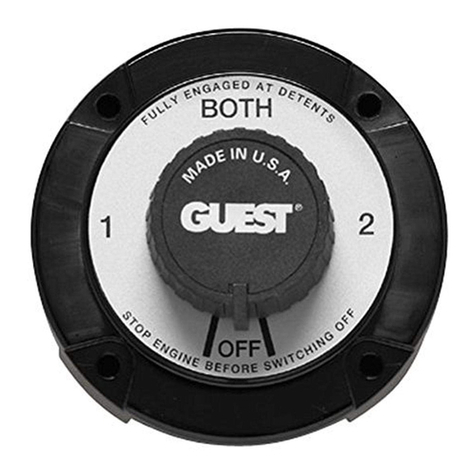
Guest
Guest 2110A manual
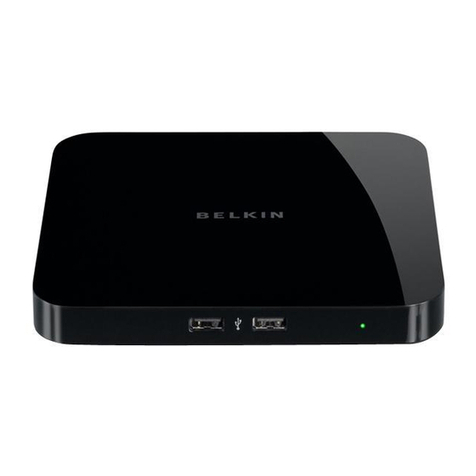
Belkin
Belkin F5L009 - Network USB Hub user manual

TP-Link
TP-Link Jetstream L2 TL-SG5412F installation guide

